Here at DC Histories, we try to make sense of the continuity that perplexes, befuddles, and intimidates. We discuss what worked and what didn’t. This week, we’re talking about the hero who couldn’t control his explosive emotions, Damage.
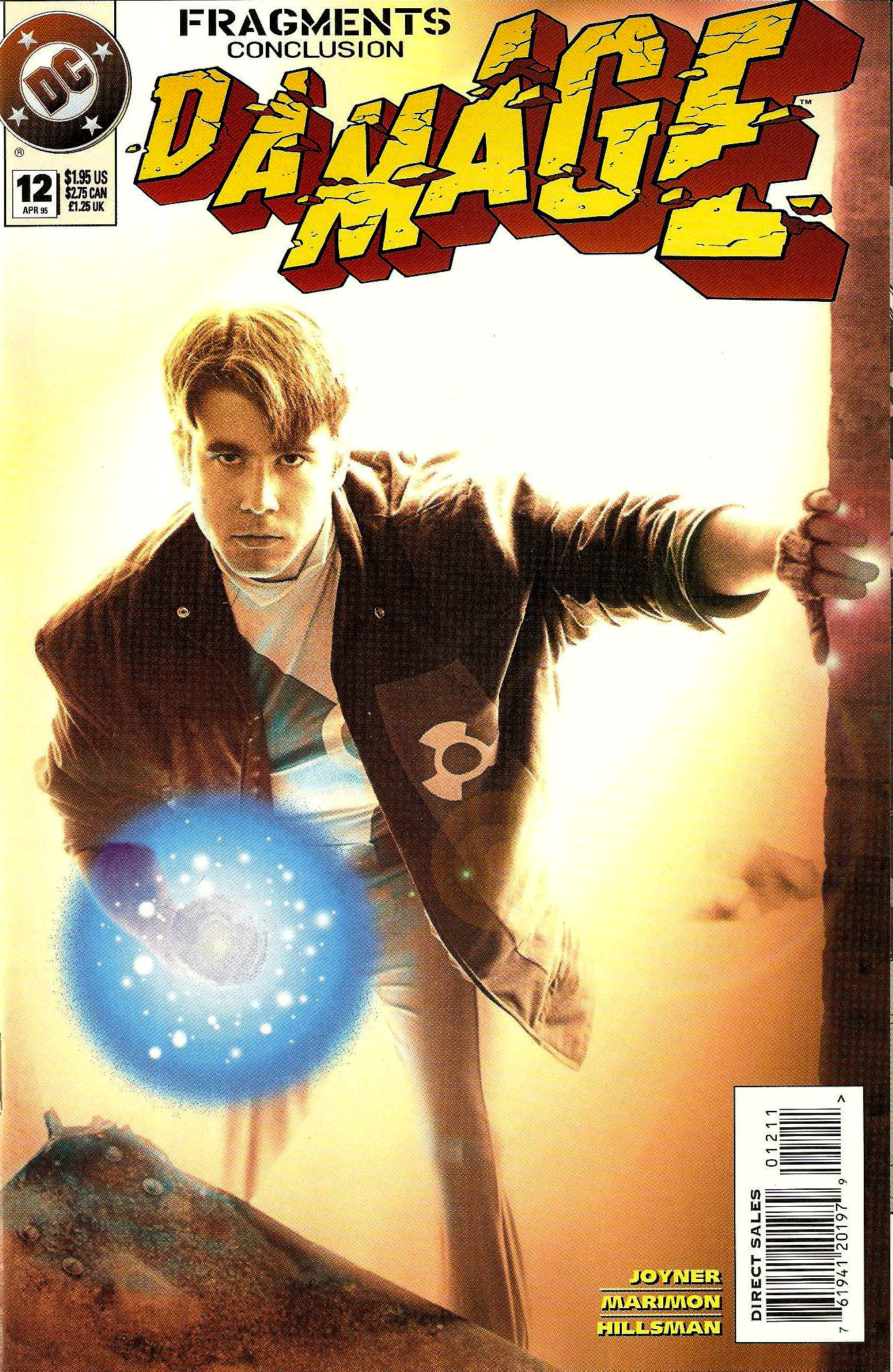
Damage #12 (1995) Cover
In a rare feat by today’s standards, Grant Emerson’s first appearance was in his own titular comic book. Without any large fanfare or appearance in another character’s popular title, he was simply on store shelves with Damage #1 in 1994. Readers of that issue discovered that Grant Emerson was just another teenager at an Atlanta, Georgia school. He was new to the school, having been moved nearly a dozen times in his young academic career thanks to his father’s job in a technological firm.
Things went south for Grant from the get go in his first issue. A price was put on Grant’s head and Metallo, mostly known as a Superman villain, took up the contract. He attacked Grant in the middle of a school day. Having never been in a fight with a supervillain, Grant fought back as best he could. As the battle continued, a terrified Grant felt himself getting stronger and stronger until his body exploded with concussive energy. This nearly vaporized Metallo and the evacuated high school.
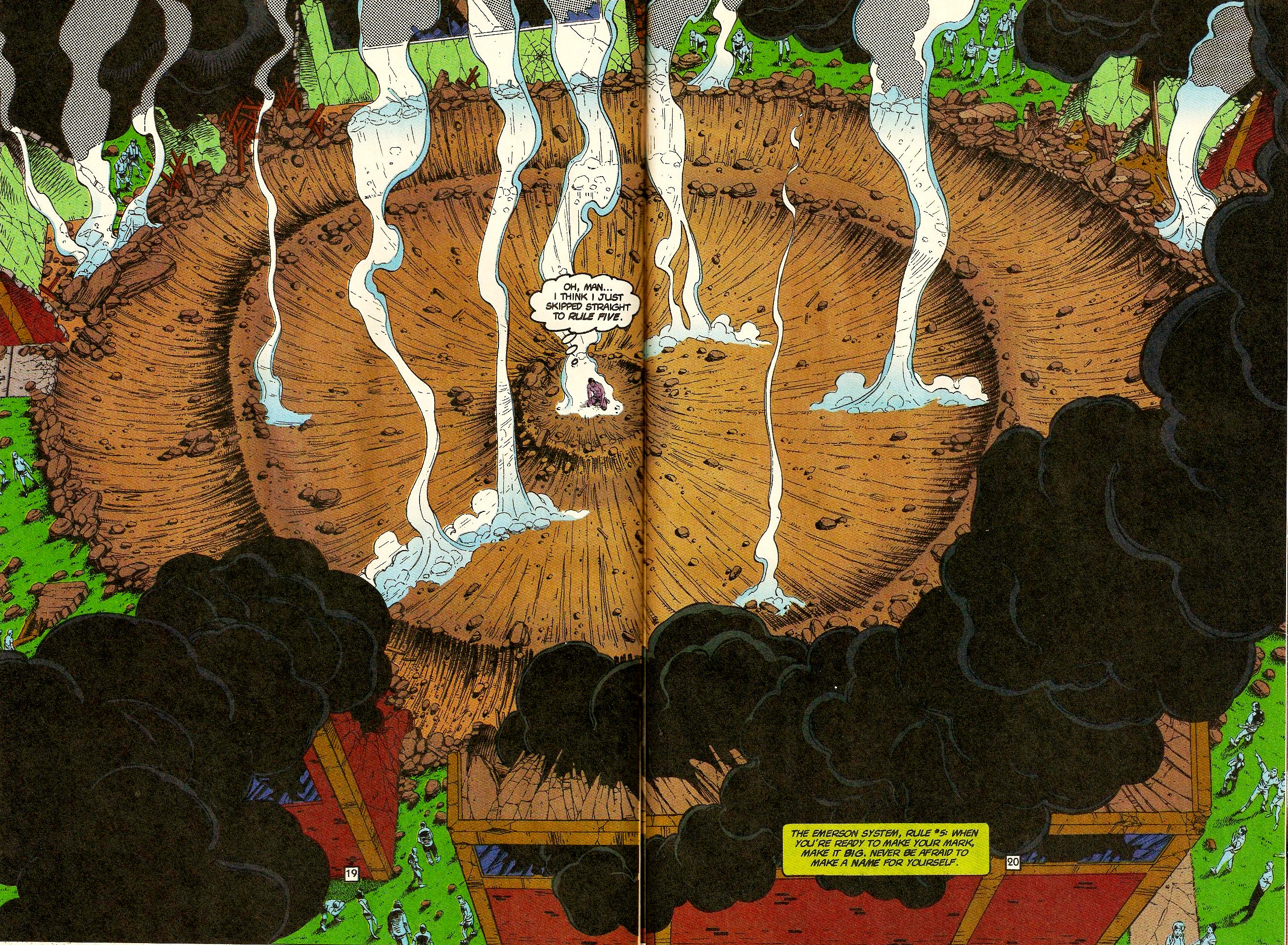
From Damage #1 (1994)
Grant wanted answers. Who put the hit out on him? Why did he have these powers? These questions led Grant down a rabbit hole where he discovered that his parents weren’t his biological parents. They were both employees of the firm his father worked for. They had been assigned to look after Grant but that was it. They barely even liked the kid. When they were told to kill him, they didn’t think twice. Their efforts to kill their adopted son were unsuccessful but their betrayal remained lodged in Grant’s memory. Also, that pesky problem of Grant storing up energy and releasing it in bursts kept popping up. Due to the destruction he was unleashing to the areas around him, he took to calling himself “Damage” and even made himself a superhero uniform.
After six issues of his own series, Grant was pulled into his first major crossover event. In the pages of Zero Hour, Hal Jordan began a campaign to destroy the universe and remake it “the right way.” He succeeded in his attempts to wipe out time and space except for a small cadre of superheroes saved by the time traveling figure known as Waverider. In an effort to force the universe to restart without the interference of Hal, Waverider asked all of the energy shooting heroes to focus their attacks on him. He filtered their energy to Grant, which caused him to swell to even greater heights. He exploded, which resulted in the Big Bang.
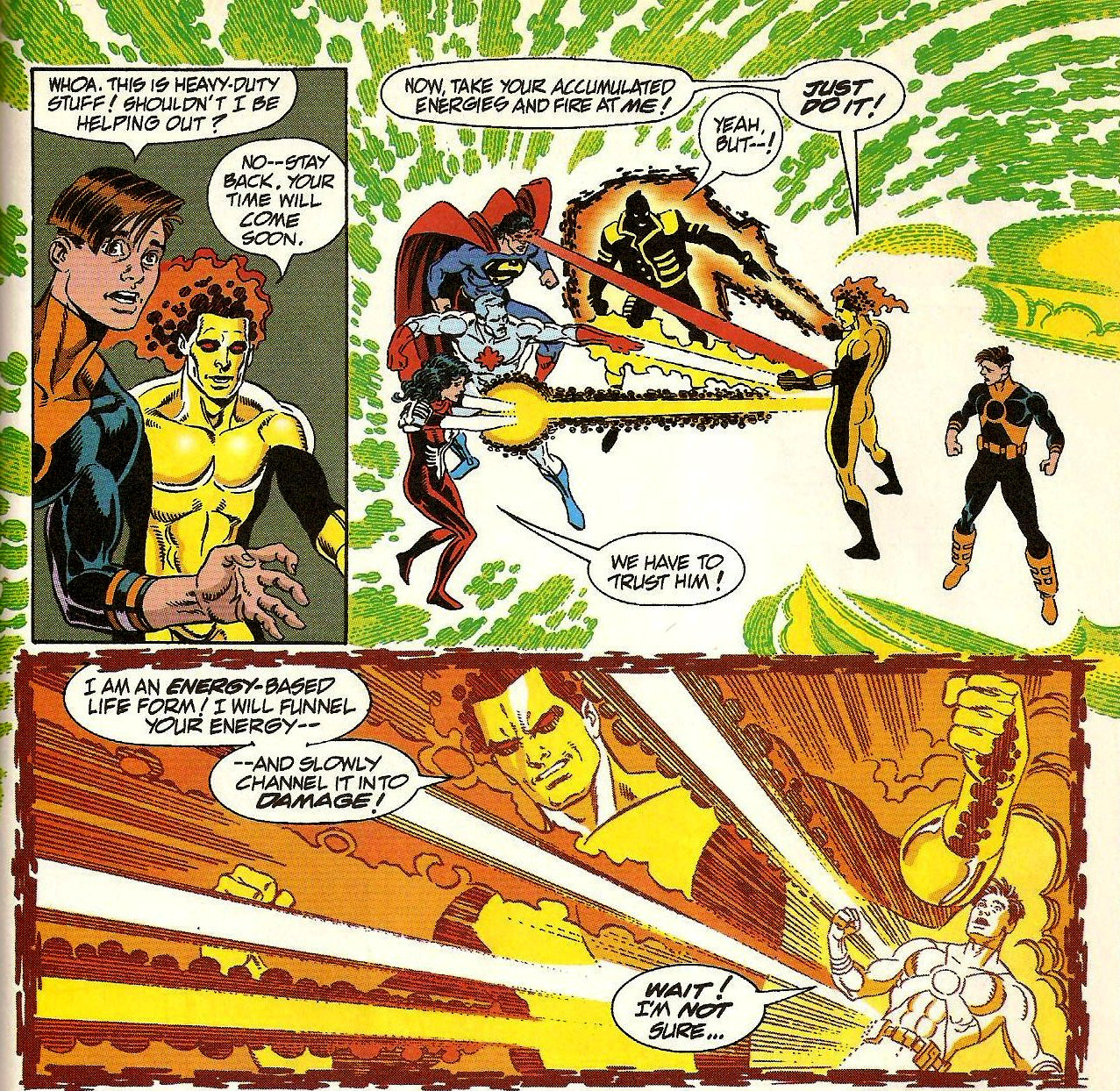
From Zero Hour #0 (1994)
The universe reset itself. Grant was now responsible for everything in the universe.
That didn’t stop him from making a mess of things after he got back to Atlanta. There, during a fiery showdown after a two-day straight battle, Grant completely lost control and took out a large chunk of the downtown area. No one was killed, but several people were hurt. Realizing his guilt in the matter, Grant turned himself into the authorities. During the subsequent trial, the good word of J’onn J’onnz and a little federal interference kept Grant out of jail but it also kept him out of Georgia. He was now banned from the state. He was also court ordered to join the New Titans so that someone could keep their eye on him.

From Damage #7 (1994)
Though forced into the Titans, Grant took to the team surprisingly well. He lived with them in New York City, far from Atlanta and the site of his largest failure. Alongside a few people his own age, including one of the various Terras in the DCU and Impulse, Grant made a few friends. The team also had a few older members who Grant could look up to including Kyle Rayner, the newest Green Lantern, and Roy Harper, then going by the name Arsenal. That first Christmas in New York was a happy one for Grant.
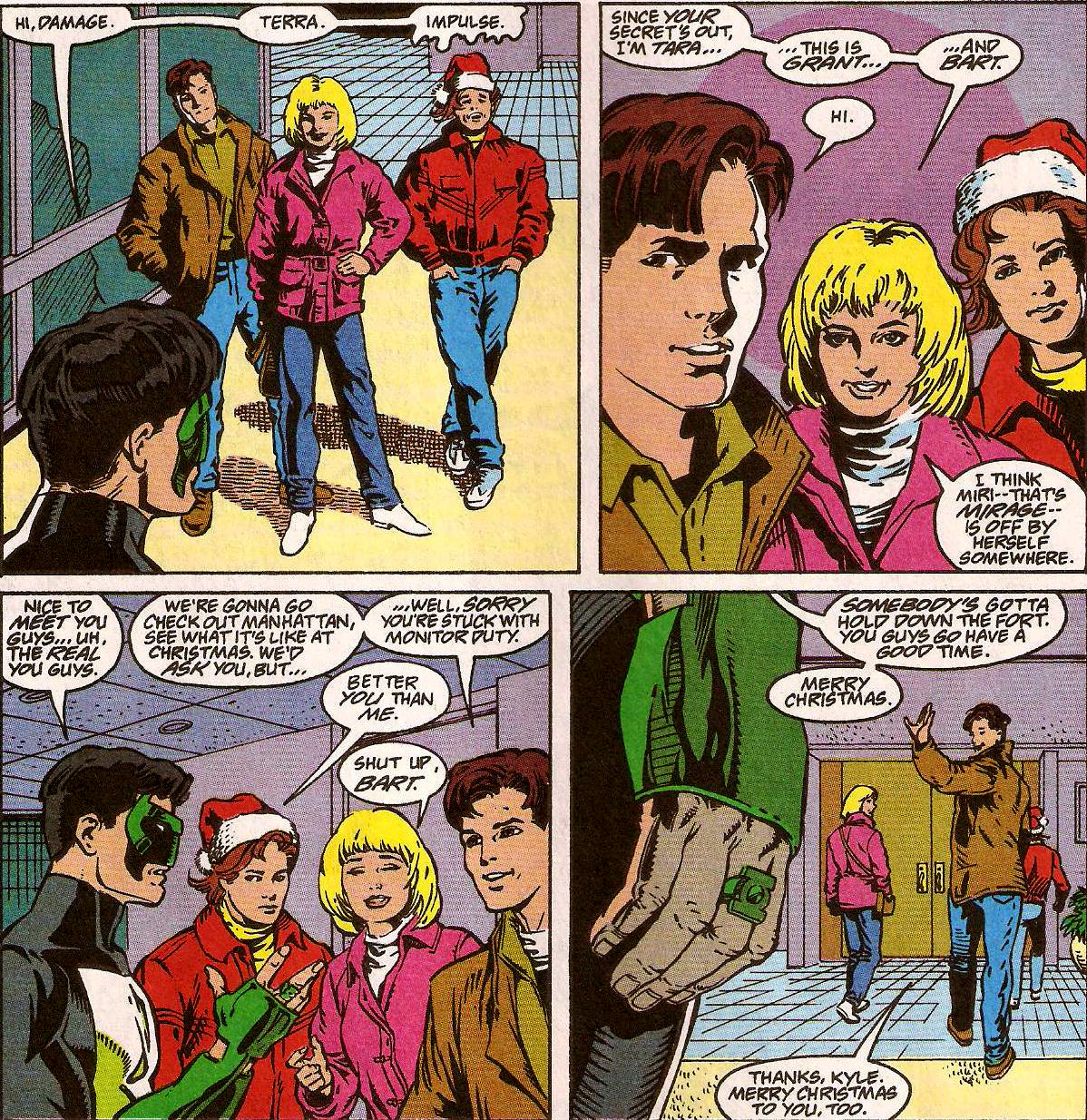
From Green Lantern (Vol. 3) #59 (1995)
Ever present in Grant’s mind was the question of his true parentage. During his early adventures, Grant was under the impression that he may be the son of the first Phantom Lady and Iron Munro, a World War II hero introduced as a Superman analog when the Golden Age Superman was retconned out of the DCU following the Crisis on Infinite Earths. The truth turned out to be much more complicated than that.
It turned out that Grant Emerson was the son of Al Pratt, the Golden Age Atom, and Al’s wife. Al didn’t have the shrinking powers of Ray Palmer, the Silver Age Atom. Instead, Al was a short dynamo, a hero with a Napoleon complex who was quick to solve problems with his fists. Over time, he developed an “atomic punch” that allowed him to unleash a blast of energy through his fists. During a time when the Justice Society of America was out of the picture, Grant was born but then given up for adoption.
This is the story that would most be discussed in later comics. However, Grant was more than just Al’s son. It seemed that Vandal Savage, evil immortal caveman, owned the company that employed Grant’s foster father. When he learned of Grant’s lineage, he thought that the boy could be even more powerful. In an effort to experiment with powers, he injected young Grant with DNA from dozens of other heroes. Grant was a test tube for dozens of other heroes’ genetic material.
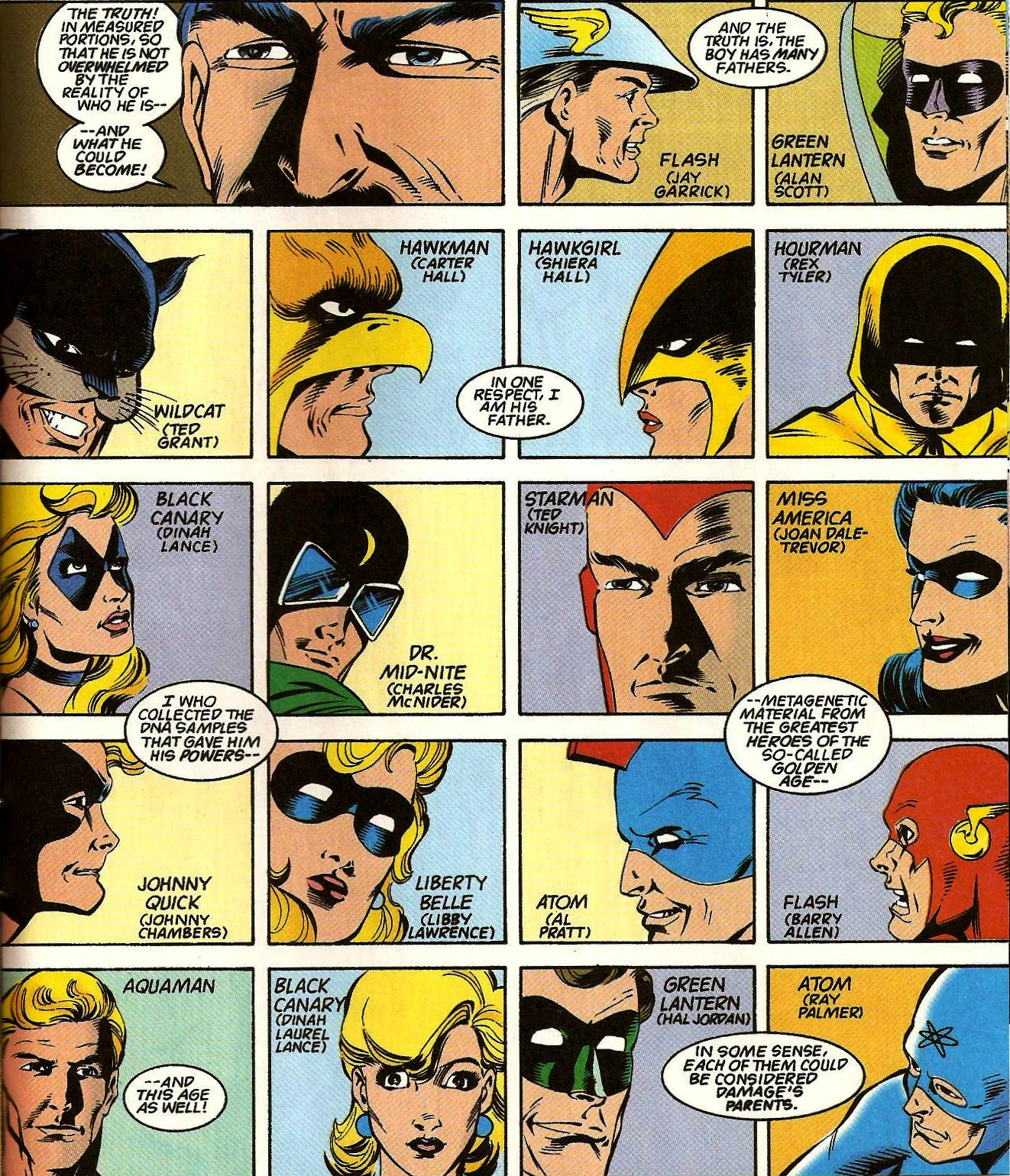
From Damage #15 (1995)
It just seemed that Al’s powers were the dominant ones in Grant’s body. A few issues later, Grant discovered that he even had the ability to fly with limited success.
Most of this backstory, and his ability to fly, was forgotten as soon as Grant’s solo series ended with its 20th issue. Future writers focused on Grant being Al’s son, which was for the best. His having dozens of “parents” was a story idea that lead nowhere.
For the next few years, Grant stayed on with several different groups of Titans. From the New Titans to just the plain old Titans, Grant kept his membership with that organization going. He also learned to weaponize his explosions. For example, during the Day of Judgment event, Grant attempted to fight off demons in the subways of New York along fellow-Titan Argent.
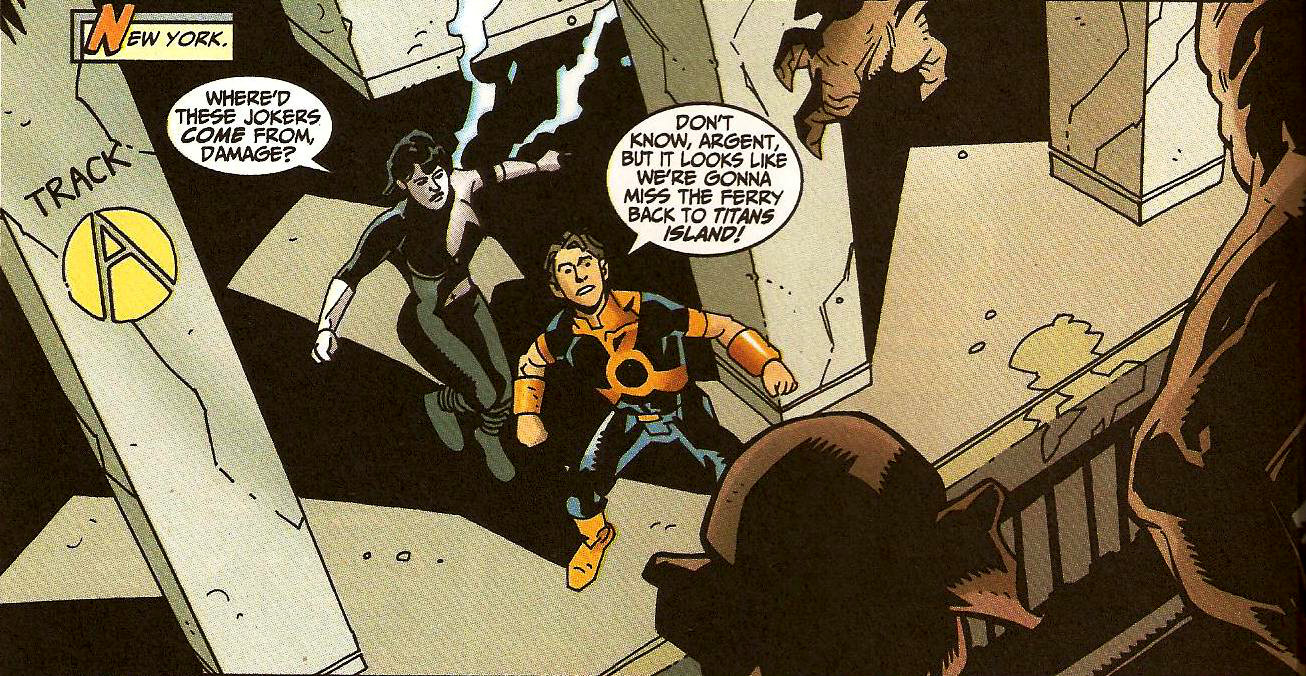
From Day of Judgment #1 (1999)
However, that changed a few years later. During a massive battle between the recently reformed JSA, the evil wizard Mordu, Alan Scott’s son Obsidian, and Eclipso, Grant arrived on the scene as a member of the Freedom Fighters. Another group of Golden Age heroes, the Freedom Fighters were lead by Uncle Sam, the living embodiment of America. Alongside heroes like the Ray and Black Condor, Grant held his own. Though he didn’t get a single speaking line during this adventure, he was occasionally drawn in the background of a few fight scenes.
It was never fully explained how Grant became a member of this organization, but he fit in with them well. He seemed to essentially be the next generation of the Human Bomb, an original member of the Fighters.
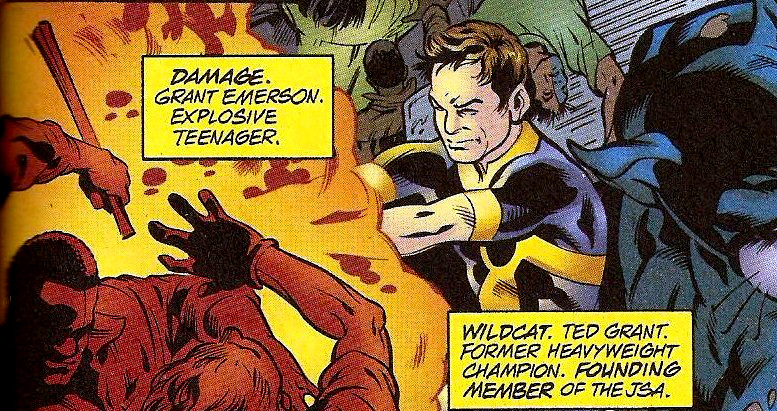
From JSA #49 (2003)
The Freedom Fighters were dealt a harsh blow when Infinite Crisis hit. While going up against members of the Secret Society, the fighters were decimated when Ray was grabbed for a nefarious purpose. Black Condor, the Human Bomb, and Phantom Lady were killed while Zoom destroyed Damage’s face with both his fists and an explosion.
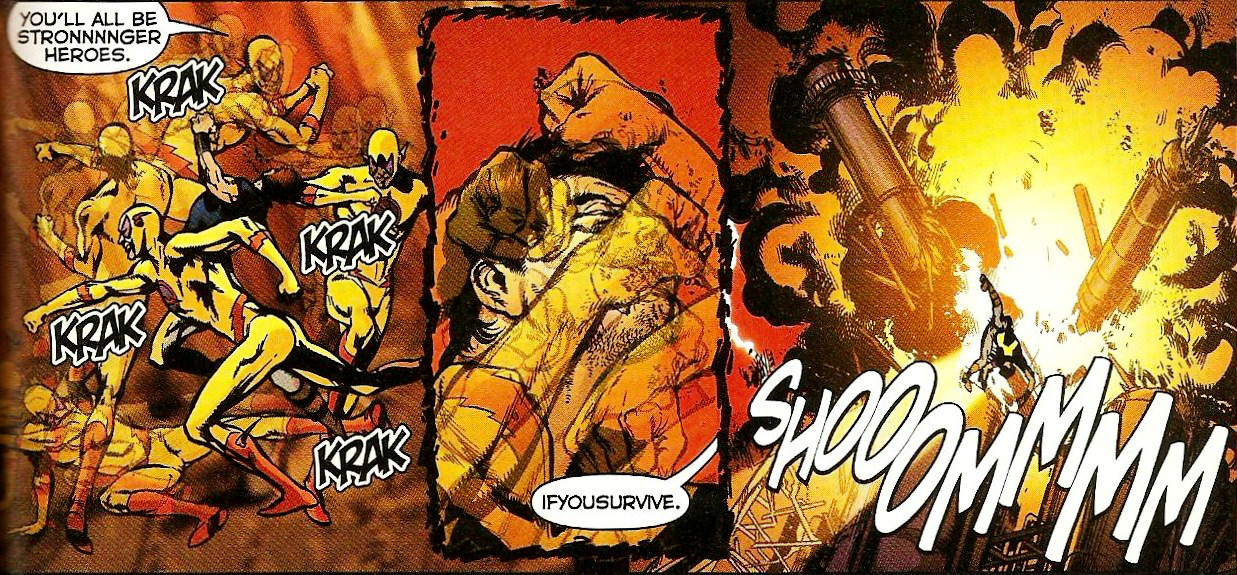
From Infinite Crisis #1 (2005)
After lying low for a while after the team’s annilation, Grant joined a newly revamped Justice Society of America. They were undergoing a pledge drive in an effort to allow any son, daughter, sidekick, distant relation, or identity thief who had ties to any member of the original Golden Age Justice Society join the organization. Though he resisted at first, Grant eventually joined the group.
Thanks to his disfiguration by Zoom, Grant took to wearing a variation on his father’s old costume. His father’s blue, full-head mask became his own and where an atomic symbol used to reside on the chest, Grant wore a biohazard symbol. Grant also wore a giant chip on his shoulder.
When Zoom ran across the JSA soon after Grant joined their ranks, Grant followed the speedster into the city of Atlanta. Still officially barred from entering Georgia’s borders, Grant ignored the law when he fought Zoom inside a courtroom. Only the timely arrived of Hourman and Liberty Belle allowed Grant to calm down before he once again exploded inside the city.
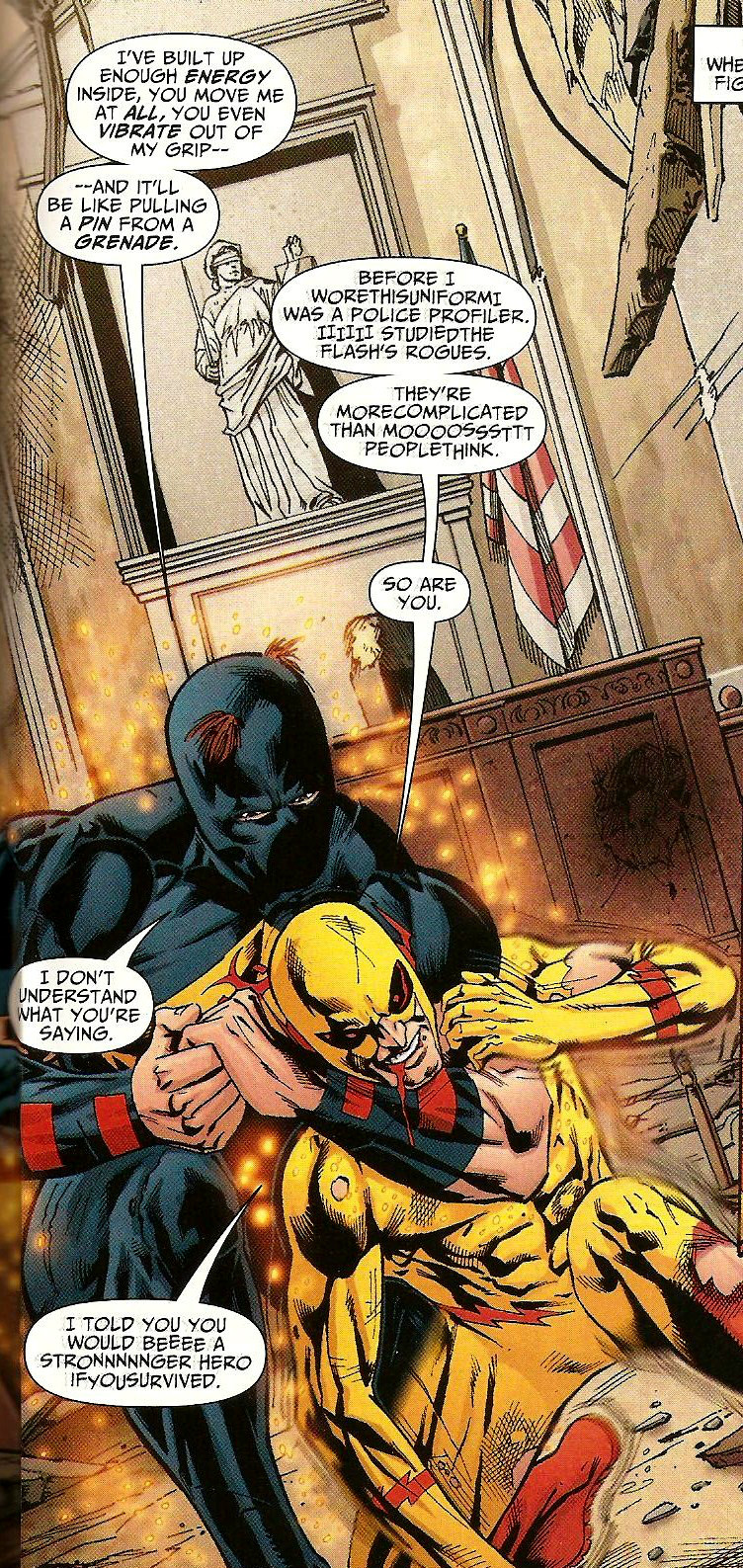
From Justice Society of America (Vol. 3) #8 (2007)
Grant’s prickly side continued to shine throughout his time with the JSA. However, Liberty Belle and Hourman helped Grant try to bring forward the young boy who had been a member of the Titans and the Freedom Fighters. They helped him to move past the scars on his face. Over time, their counseling bore fruit.
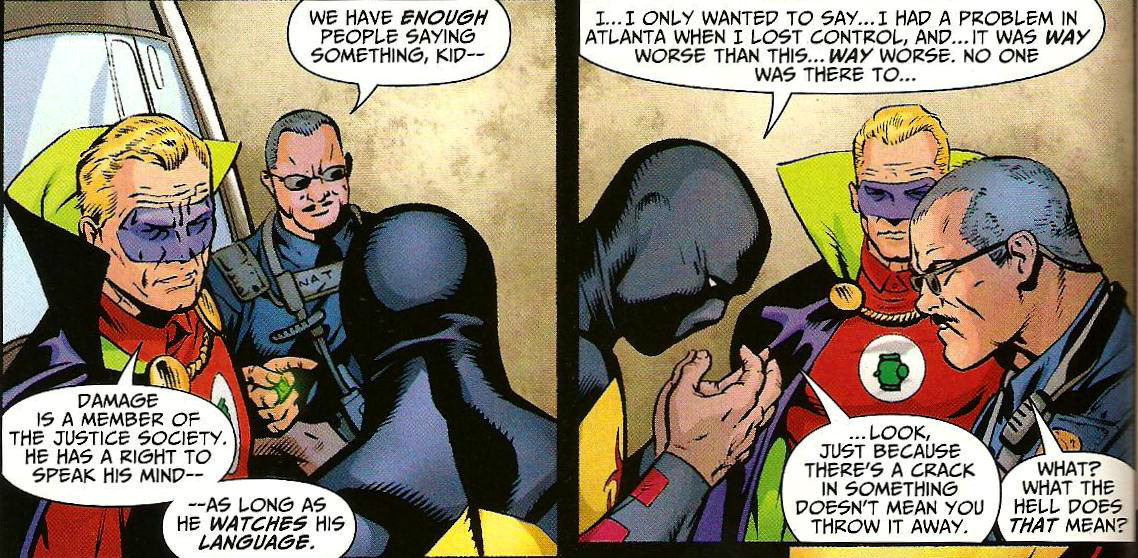
From Justice Society of America (Vol. 3) #11 (2008)
Occasionally, Grant lost his way. When the alien god Gog gave him back his normal face, Grant would have done anything Gog said. This could have been a strong story but the whole thing deflated at the end and Grant ended up with his scarred face again.
Grant was presented with another role model soon after Gog went away. Albert Rothstein, otherwise known as Nuklon and Atom Smasher, was the godson of Al Pratt. While Grant had never met his father, Albert was like a son to Al. Albert and Grant had met before and spent some time together, but it was only after Albert rejoined the JSA that he began to take Grant under his wing. It helped that they both had the same mask.
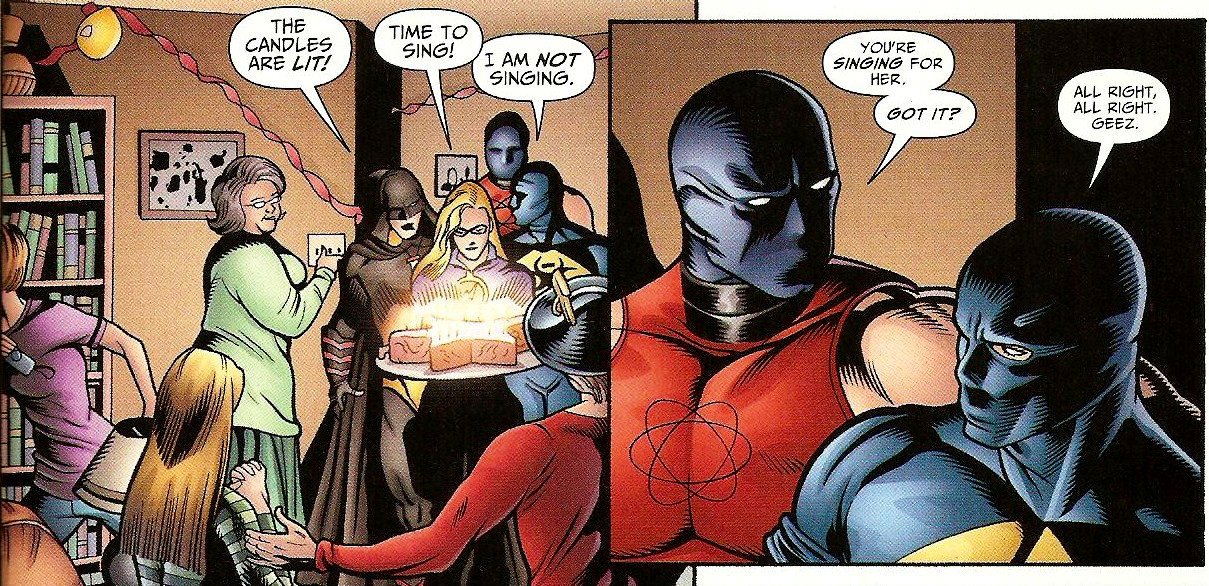
From Justice Society of America (Vol. 3) #26 (2009)
Grant has a history of getting into some big scraps during giant DC events and Blackest Night was no different. This time, however, instead of getting his face beaten in or his body used to start the Big Bang, Grant was killed by a Black Lantern Jean Loring, Ray Palmer’s ex-wife. Just at the moment when his hope was at its highest, Grant’s heart was torn out of his body. His death was the thing that brought the Black Lanterns’ power to a full 100% and unleashed Nekron.
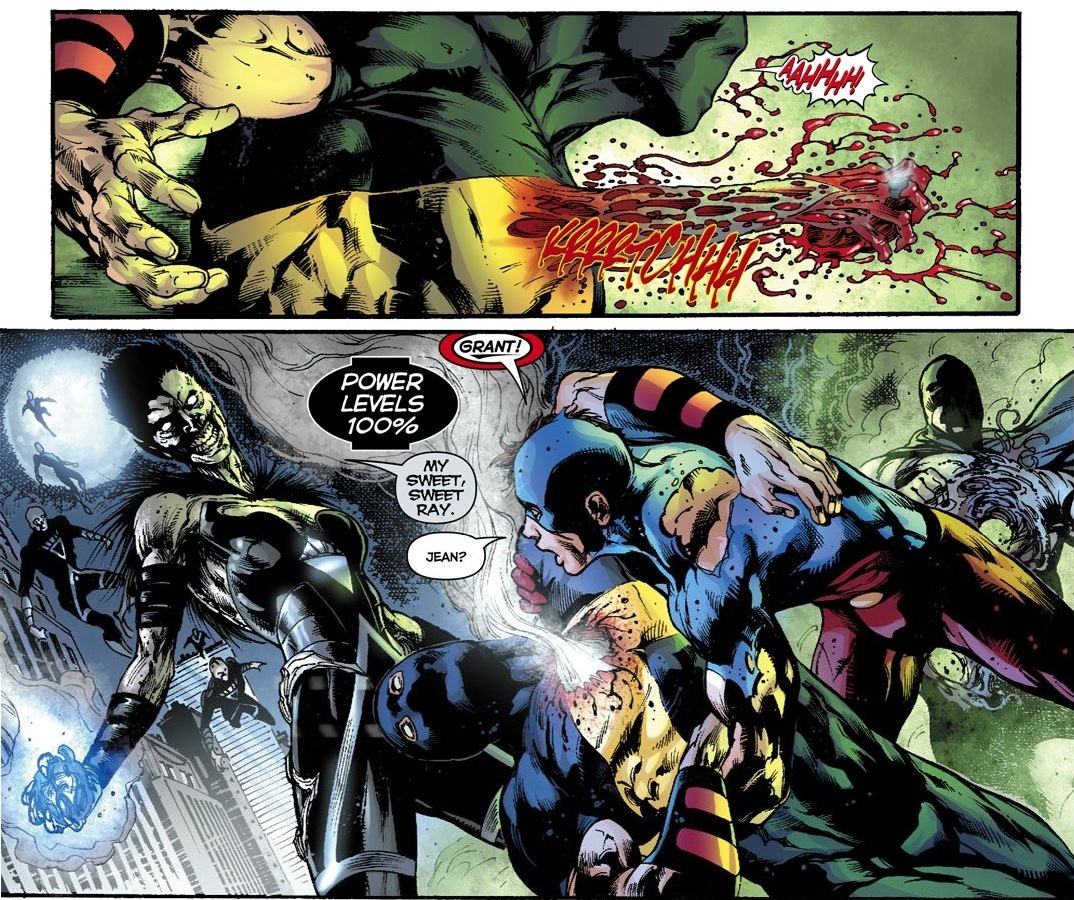
From Blackest Night #4 (2009)
Unlike a few other heroes who died during this event, like Hawkman and Hawkgirl, Grant stayed dead. When everything was said and done, a funeral was held for Grant. Every member of the Justice Society and the Titans came out to give their goodbyes to their friend. Sonia Sato, the latest Judomaster and the women whom Grant was dating during his final days, gave his eulogy through tears. Also in the crowd was Iron Munro himself. Though he hadn’t turned out to be Grant’s father, he did have a special relationship with him.
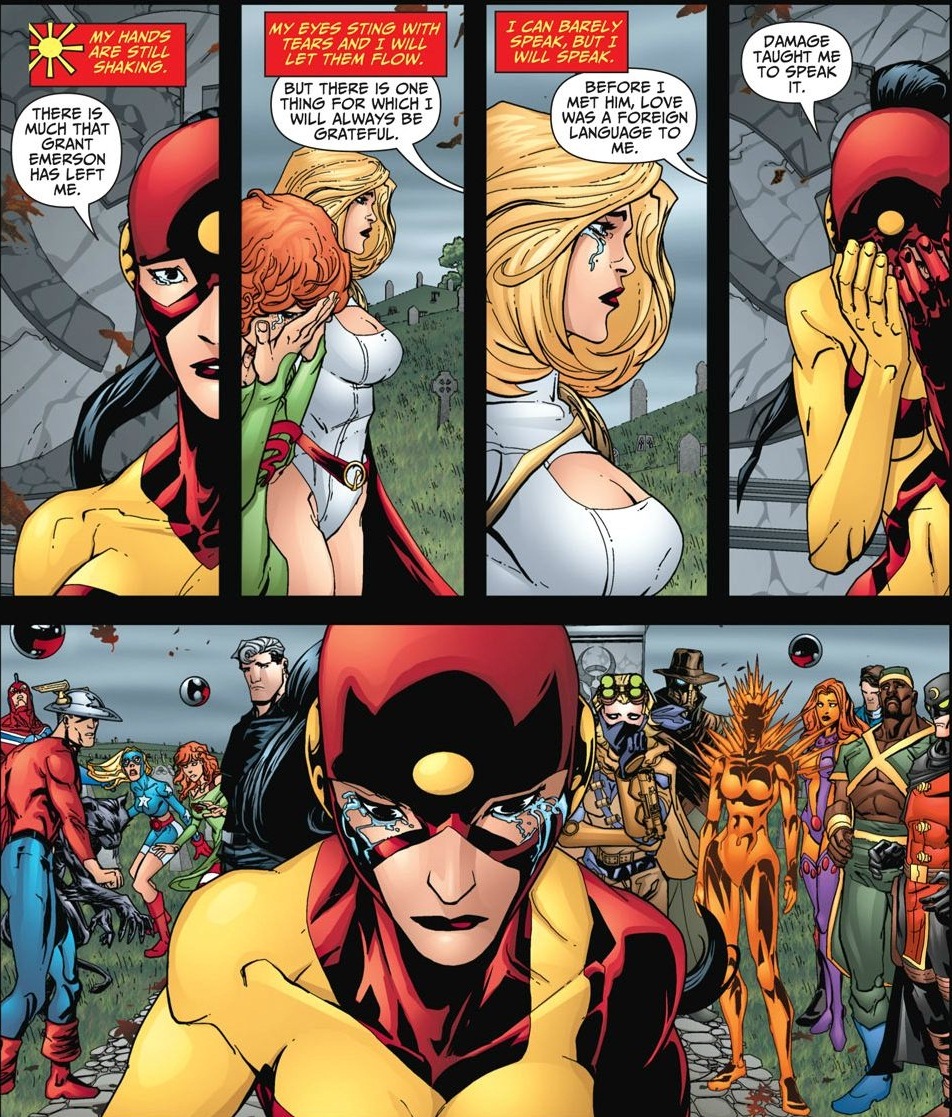
From JSA All-Stars #7 (2010)
That’s where Grant remained until the New 52 rebooted everything.
While Al Pratt has shown up in the pages of Earth 2, alive for the first time since 1994, his two legacy characters remain MIA. Both Albert Rothstein and Grant Emerson are nowhere to be found since Flashpoint came and wiped everything away. With Al now a much younger man than he was during his final days in the DCU, it should be safe to assume that neither of these characters will be back anytime soon.
For a character who lasted only 16 years of continuity, Grant Emerson managed to tie himself to a surprisingly large cast and showed actual growth over the course of his career. Here’s hoping he’s not forgotten forever.
Jeff Reid has a soft spot for the teen heroes of the mid-90s. He’s covered them all now except Anima. He’ll get to her eventually. Occasionally, he’ll discuss teen heroes on Twitter.


Interesting! I didn’t read a ton of DC pre-Identity Crisis, so when he popped up in JSA I never really knew who he was other than the little bit of exposition dialogue around him. He just seemed like a grumpy guy who came out of nowhere.
but I assume you read Infinite Crisis where he was attacked with the Freedom Fighters, right? Also, just wondering, but have you since gone back and read pre-Identity Crisis stories?
Yes, I saw all that, though I don’t know if I realized it was the same guy. It’s been a while. As I recall it was a fairly brief scene and none of the Freedom Fighters were really introduced per se.
I read all of Johns’s JSA, including pre-Identity Crisis stuff, though it feels like he was brought in with little in the way of an introduction other than being the original Atom’s son. I didn’t read any of that Titans stuff, for example. It sounds like the encounter with Zoom significantly changed his general mood and personality, which is understandable.
Yup DC’s 30-40-something editors are wiping away all the continuity that occurred after they were kids. It’s almost as if they can’t handle the thought of the universe moving on without them and leaving their childhoods behind. Not that them pitching fits and souring almost all relationships with creators and changing their minds mid sentence can be related back to an infantile disposition or anything.
“He’s a NEW hero / after I started reading, so no one will REALLY mind if we wipe him/her away.”
So pleased to have the spotlight on Damage; I remember him fondly, as this was the only series I ever got a letter printed in!
Grant had nearly everything a 90’s superhero needed; a cool jacket, terrible hair and a nice line in grimacing through gritted teeth. He only lacked for the leg-pouches.
I seem to recall the story of figuring out Grant’s true parentage dragging out for a verrry long time; wasn’t Dr Polaris mentioned as another possible father at some point? His rather angsty nature & short fuse might’ve been explained by the later revelation that he was abused by his foster father.
Am I right in thinking that this book started off as one of the first (possibly only) creator-owned characters within the DCU proper?
It took about a year and a half for Grant’s true parents to be revealed. Along the way, Grant learned that Dr. Polaris was his uncle by way of being the brother of his foster father. There was tons of confusion during this time and Grant thought that, maybe, Dr. Polaris was actually his father but that was later shown to be not true.
As far as I know, Damage wasn’t creator-owned. I’ve never read anywhere that he was. However, Chris Claremont’s Sovereign Seven series was creator owned. That was an official DCU book which had characters like Impulse, Power Girl, and Superman guest star in its pages. As far as I know, the Seven never appeared outside of their own title and after the series was cancelled, they never appeared again.
I love these Histories! They are always fantastic.
Always had a softspot for Damage. He had that great angsty thing that so many of our 90’s heroes had going on. And now they’re all gone. The universe is, ironically, less bright without them.